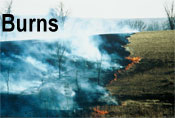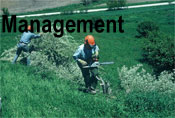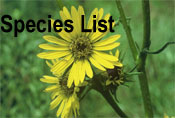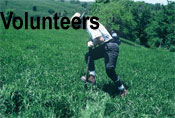






Prescribed Burns
A few thoughts about our prescribed grass fires that may be of help to your planning follow:
CLOTHING: leather work gloves, leather work boots or shoes, natural fiber clothing including long sleeve shirt & hat, glasses or protective eyewear, bandana (PPE if you have it-Nomex, helmet, etc)
Natural fibers like cotton (but NOT silk) are best for both outer & inner wear. Although, an ember may set cotton cloth to smoldering and cause a burn, artificial fibers are worse because they will melt and stick, causing worse burns. Both artificial fibers and silk also conduct heat in unexpected ways and can cause burns even when seemingly intact. Conduction through silk or artificial fiber underwear can even cause a burn through intact and undamaged cotton outerwear!
Frayed clothing is more susceptible to ignition than are newer garments. Loose or exposed hair also may singe or burn (as happens to Sandy's beard nearly every burn), so at least a cap is useful for preventing impromptu natural restyling.
Air temperature changes, proximity to the flames, and exertion all require adjustment of clothing for comfort. Several layers of easily removable outer wear are better than one.
Sturdy leather shoes or work boots will serve to protect ones ankles while moving quickly across rough ground.
Leather work gloves also will be needed to protect your hands.
SMOKE, ASH, ETC.
Our fires are first lit along the downwind edge of a burn unit to make a black line. The wind hopefully will push later flames toward the already burned area. The creation of this downwind black line is one of the most important jobs for controlling a burn. The backing fire along this downwind edge will expose the crew to heavy smoke. A DRY bandana is of some help; do NOT wet a bandana, wet cloth will conduct excessive heat and may cause burns. We try to have a large enough crew that folks can get out of the heaviest smoke to get their wind back, but, at times the smoke seems to maliciously follow the person having the greatest difficulty with it. With the reduction in grazing pressure, we also are seeing more poison ivy which can increase the hazard of smoke inhalation.
Sun or safety glasses will help keep ash & dust from your eyes (the smoke will get to them anyway). Contacts should NOT be worn!
If you know you may be allergic to something like wild sage or poison ivy smoke, have an exertion related condition or sprained joint, react strongly to bee stings, or have other health related concerns which may impact your ability to work the fire line, please let us know in advance so that we can plan our crew assignments to minimize risks to your health.
FOOD & WATER: personal water bottle that can be attached to you, pocket snack
Once we have ignited a burn unit, there is no time to relax for a leisurely break until the burn unit is completely surrounded by fire. It thus would be wise for you to bring along your own easily portable water bottle(s) and at least a snack.
COUNTRY ROADS
You will encounter typical hazards traveling the county rock roads to our farms‚ headquarters at 2549 I Avenue. Loose rock, dust, slow moving farm equipment, speeding pickup trucks, blind driveways & field entrances, wandering livestock, blind poorly-controlled intersections, narrow bridges, no shoulders, deep grass-hidden ditches, encroaching trees, etc all require defensive driving. Please be careful.
SCHEDULING (& CANCELLATIONS)
We will try to schedule a burn as far in advance as we can. Unfortunately, for us to be the least uncomfortable with setting a fire, we must have very specific conditions (excluding the obvious worst case weather conditions like a burn ban or rain fall on a scheduled burn day). The less obvious include:
The right wind conditions (too high & the fire can get away too easily; too low and we can’t anticipate the direction that it will burn!).
The right wind direction & consistency (the wrong way and we could blow embers into barns or smoke on the wrong road; too much of a predicted shift and the fire will move the wrong way).
The right relative humidity (too low and the fire is too volatile; too high and the fire burns too irregularly).
How much green growth there is in the fuel affects how fires react to the weather variables - - the more green the grass (which increases in the spring but decreases in the fall) the less volatile are the prescribed fires. Thus, the greener the grass, the lower the humidity and/or the higher the wind we can tolerate for a reasonably safe burn.
We must consider the number of folks who have committed to help us with respect to the difficulty of the particular unit targeted & ready to burn - - too few crew and the burn could be unsafe to start. Another variable with fall burns is whether our neighbors have gotten their adjacent crop fields harvested - - we will not burn if there are standing crops too near.
What this all means is that our larger burns (more than about 20 acres) must be done on a weekend; smaller areas may be scheduled at the last moment (the evening before) to be burned on a weekday. If you haven‚t already let us know of your weekend / weekday availability by phone or e-mail, please do so now.
YOU - Please check your e-mail & phone messages BEFORE you leave for our burn to be sure we haven’t cancelled.
ALL BURNS ON BURN DAY:
Please be on-site at our pole barn, 2549 I Avenue, Pilot Township, by 9:15 AM(unless otherwise directed). Park near pole barn in mowed area but do not block access to barn doors. We may ask you to help with last minute equipment preparation or loading. We then will car pool or walk to place of initial ignition for burn. We need help from the time the first match goes down until the burn unit is completely ringed with fire (usuallyno later than 5 or 6 PM and often earlier if things are going smoothly). Both all day and half day schedules can be workable if we can time shift hand-offs to keep fire adequately staffed. It also is very appreciated if some of you can stay to help patrol the fire line a couple of times before dark (to make sure all is as safe as it can be) and put equipment away.
Before the grass is lit, we will assess the weather one last time - - if the conditions are more extreme than the last weather prediction, we may be forced to cancel at this point (yes, it unfortunately has happened to us once in the last 14 burns). If we are forced to cancel at the last moment, we can take those who want to stay on a short tour of some of our prairie remnants and/or even have a short work session on one of the remnants if anyone is interested.
For those of you who live more than 1.5 to 2 hours away, it may be impractical to hope to help with a burn. The weather dependence of fire behavior makes last minute decisions too important to ignore. So....., let us know if you want us to keep you informed by e-mail about our burn plans just in case and we gladly will. Or, if you will be closer to our area during burn season (15 Oct - 30 Nov and 1 Mar - 15 May) let us know when and how to contact you to keep you informed about our changing plans. Or, we also will gladly accept help with brush clearing on our prairie remnants and fire breaks.
Coursework sponsored by National Wildfire Coordinating Group (NWCG) is encouraged.
Please contact us if you are interested in assisting with any future burns:
Judy Felder - jjfigh@gmail.com
Thanks again,
The Indiangrass Hills folks in Iowa County
Return to Top
